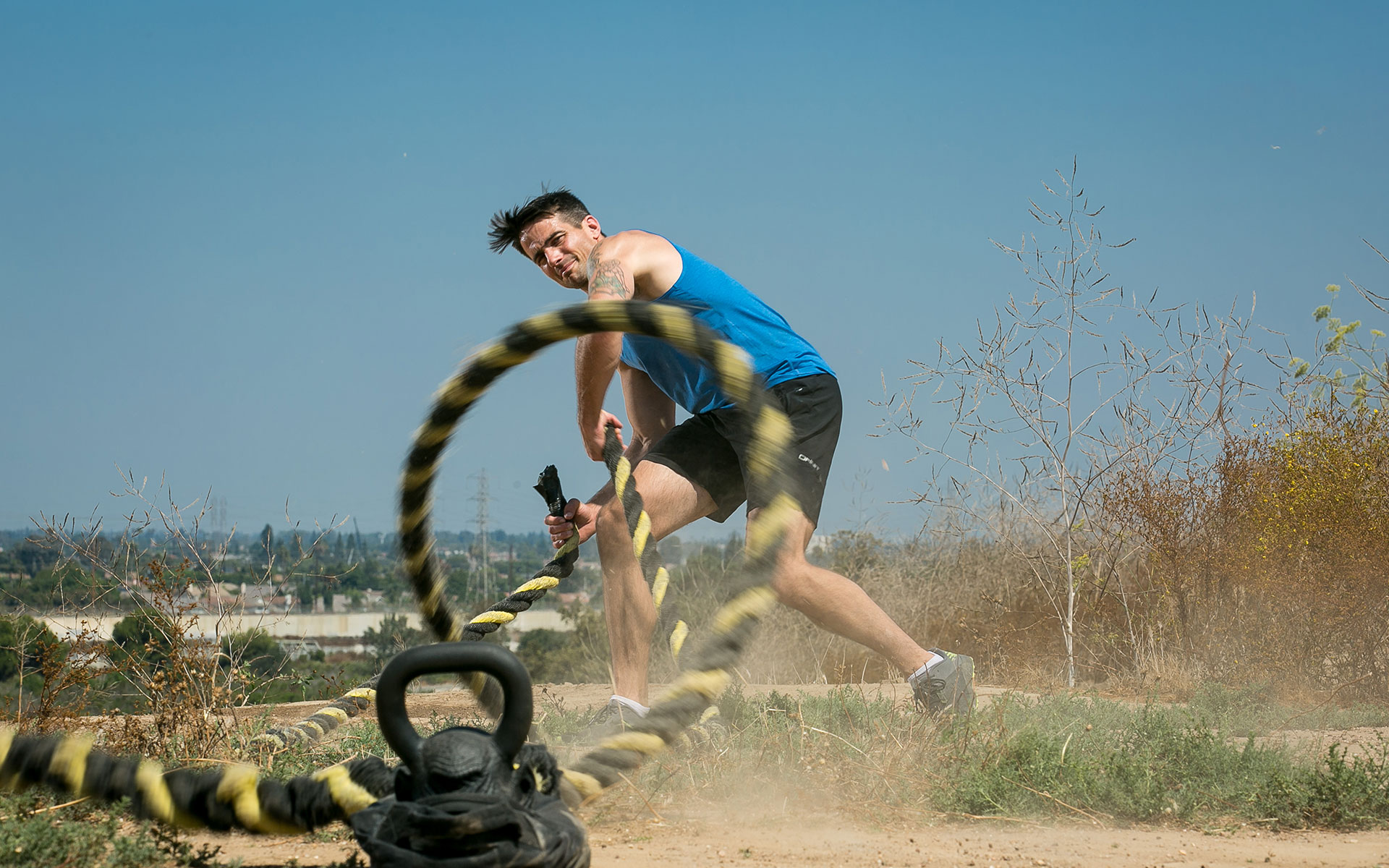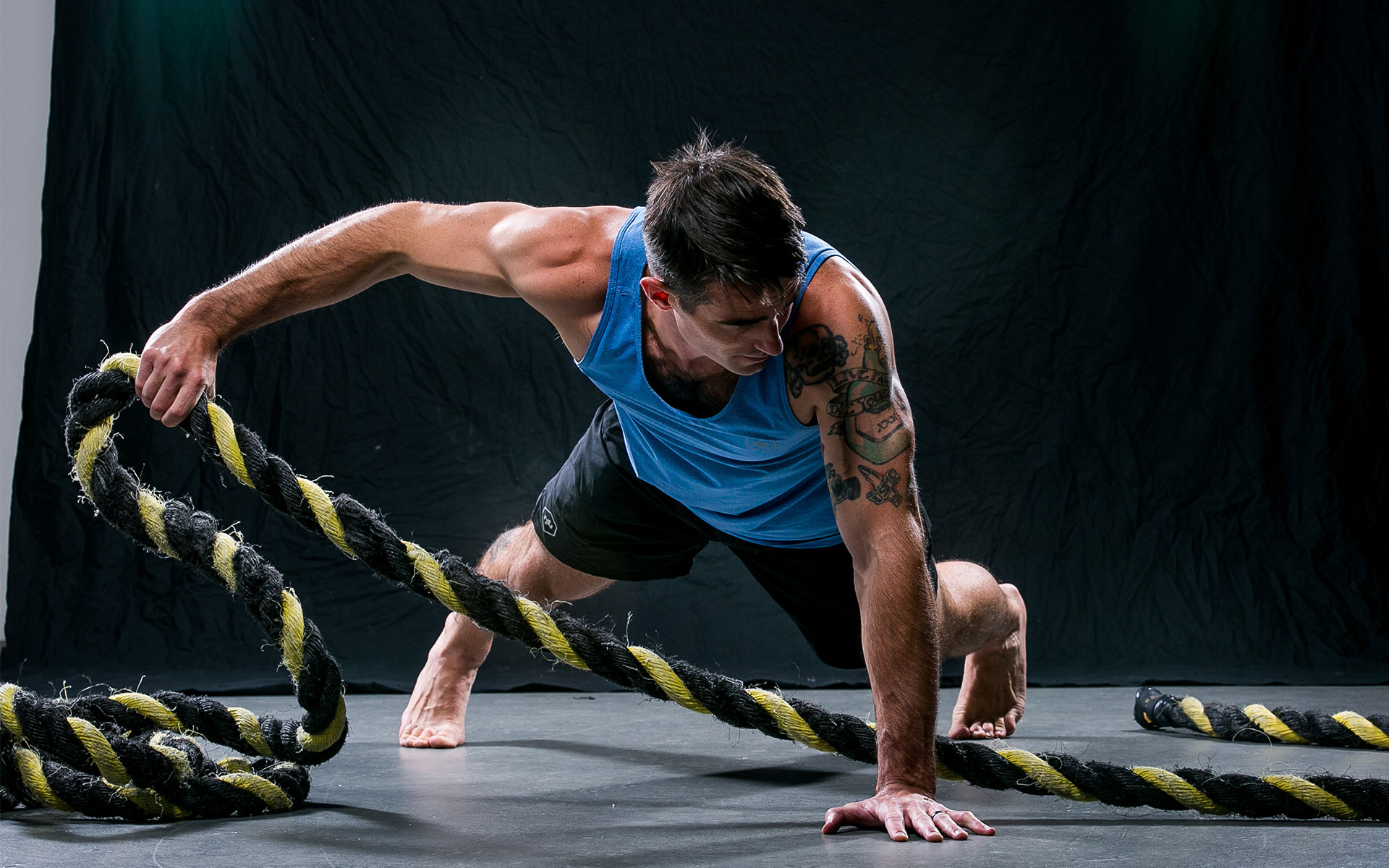TOP 9 ASPECTS OF TRAINING COMBAT ATHLETES
0
0Top 9 Aspects of Training Combat Athletes – Why I Train Each Aspect with a Battle Rope
Master Coach Aaron Guyett runs us through the top 9 aspects of training combat athletes
Here are the the Top 9 Aspects of Training Combat Athletes:
- First Step Speed
- Agility and Quickness
- Full Body Power
- Full Body Strength
- Full Body Endurance
- Grip Strength and Endurance
- Hip Power and Strength
- Rotational Power and Strength
- Mental Toughness
When programming for a combat athlete, there are many things to consider, and so many areas that the athlete needs to have improved adaptations in. After reading the principles of programming for combat athletes, and watching the video, I am certain you are taking all programming needs into consideration. Now let me explain how to go about the top 9 aspects of training combat athletes, specifically with the battle ropes. I don’t exclusively use battle ropes, but I could. The battle ropes are one of the most effective and versatile combat athlete training tools that exist, and they have been around for tens of thousands of years.
First Step Speed
Without first step speed, there is no knock-out punch, kick, or take-down. The combat athlete will have a tough time generating enough snap and pop in her throws or take-downs. First-step speed is crucial for all combat athletes whether in the ring, in war, or on a mat. It is more about innervation, the brain, and the peripheral nervous system recruiting enough muscle to do what the athlete desires when initiating a violent or fast movement. The battle rope is a perfect tool to not only train the speed necessary, but to see the movement articulated down the line of the rope. When I train this, I use the full length of rope, and I only do one or two movements at a time. I first increase the neural drive though some isometric loading for 5 to 10 seconds, driving engagement up to 100%, for 2 to 6 sets, depending on the combat athlete’s ability and focus. Once they are prepped I have the athlete perform 1 to 3 reps of their first step speed movement (i.e. a hook, or an arc, or a jump with a slam), and I have them perform this for 5 to 10 rounds, with maximal rest to ensure they are training with this highest speed possible. This is similar to plyometrics, and should only be performed twice per week, and for no more than 40-80 total sets (depending on the athlete and the output). I cannot stress enough that maximal effort, perfect quality, and maximal speed is crucial to create the stress on the human system to create an adaptation.
Agility and Quickness
Agility and quickness is trained in much the same way as first-step speed, except that you will most likely add some extra reps, and you can increase the variability of your movement. Each combat athlete must possess the ability to move with speed, intensity, and agility in their feet, hands, limbs and torso. Without speed, agility and quickness, you will succumb to your opponent’s speed, agility, and quickness. Think about using the rope as a line/boundary for your movement production or as a way to articulate your speed, agility, and quickness down the line of the rope, whether it is full length or double rope. I often tell an anecdote when I talk about overspeed or supramaximal speed, which is crucial when training speed, agility, and quickness, and it goes like this. There was a study on baseball players where they used a light bat to end up with higher swing velocities, rather than what most people think, which is use a heavy bat to swing faster with the regular bat. Think about this in regards to the training you will do with your battle rope for your combat athletes. Keep them brief, so you are training your true maximal or supramaximal speed, agility, and/or quickness.
Full Body Power
The third of the top 9 aspects of training combat athletes is full body power. In any combat sport, the entire body is used to create power to effect violent strikes, kicks, take-downs, etc. Without access or understanding of the body’s ability to produce this much power output from a physiological, nervous, and musculoskeletal stand-point your athlete is going to suffer losses or worse. The battle rope provides an environment to teach the mind and body powerful movements and metabolic productions that will aid in full body power adaptations. I use power to represent the explosive, 1 to 3 repetition alactic or phosphogen bio-chemical and mechanical system. Think about knock-outs, fast take-downs, massively fast and strong reversals, etc to get a mental picture of full body power, as opposed to strength or endurance.
Full Body Strength
Strength is different to power, in that the body now is reducing the maximal output for slightly longer durations. Think about the struggle of the combat athlete when fighting to get out of a bad situation, or in outlasting the opponents grip or position to triumph with strength. I use strength as a multiple repetitive action that uses a lot of force. Think about a flurry of strikes, or take-down attempt after take-down attempt, and clinch or pummelling struggles. By extending the time, and reducing the rest with a battle rope full-body movement, compared to the above noted power, one can train the metabolic pathway to create adaptations for full body strength (lactic or glycolytic metabolic pathways or energy systems).
Full Body Endurance
Endurance is the opposite of both power and strength, in that it is the aerobic system taking over, to allow for longevity and distance to determine the win. Every combat athlete knows the suffering that exists in the later rounds or the fight that goes too long. Slogging through the physical and mental anguish of the long bouts, are only made better by full body endurance that allows for a clear head and crisp action for the physically and mentally prepared athlete. The battle rope is a perfect tool to help your athlete reach these points and push the adaptations in a winning direction. Capacity, volume, duration cannot exist without training for them. To make the aerobic capacity, and oxidative function of your combat athlete’s metabolic pathway or energy system better, one must put in the right training and programming, and a battle rope is one of the best tools for the job, especially for the combat athlete, as the movements in a fight are far more varied than jogging or jump rope. Endurance doesn’t just have to be full body, it can be regionally specific, like grip.
Grip Strength and Endurance
Without grip, you cannot fight. Without grip strength and endurance you cannot win the fight. Because the battle rope is a grip-centric tool, each athlete is coaxed into improving their grip strength and endurance without having to carve out special exercises in the athlete’s program. There are many ways to train grip strength and endurance, and battle ropes is near the top of this list. Whether you are doing pulling exercises or dynamic movements that create waves or static engagement techniques, the ropes closely mimic the grip and positions your hand will be in during you combat sport, so it is a perfect tool.
Hip Power and Strength
The dynamic snap and pop that comes from an athlete’s hip hinge is the difference between a take-down or a missing an opponent. Nothing is more humbling than kicking toward, and completely missing them or even worse hitting the opponent with no effect whatsoever. The hip power and strength is a very crucial part of the combat athlete’s arsenal, and battle ropes can make this arsenal deadly powerful and deadly strong. Whether the athlete is training the snap down in a clinch or the pop-through of a front kick, the battle rope can provide a wide-array of movements and repetition to create the desired effect.
Rotational Power and Strength
The desired effect in rotational power and strength is the same as hip power and strength, it is just trained through an entirely different plane of movement. Rotation is one of the most under-trained movements in gym around the world, but with a battle rope it doesn’t have to be. The battle ropes fluidity, allows for any plane of movement to be trained specifically and accurately to allow for force translation to go from the trained movement into live combat. For instance a hip toss, or hook, or shuck can be a movement specifically trained with the battle rope, and because battle rope output can be quantified, one can see the progress of their athlete from week to week and month to month.
Mental Toughness
Last but not least of the top 9 aspects of training combat athletes is the area of mental toughness. More of a quality, than a quantity (like power or strength). This quality needs proper programming, training environments, and tools to flesh out its effectiveness in a combat athletes program. Mental toughness is akin to perseverance in a the final round or will-power in a weight cut or discipline in a fight strategy. Mental toughness is all of these abilities wrapped up in two words. Training this quality can be accomplished in several ways: the athlete must face challenges and even failures throughout the training program, and the athlete cannot quit and even ultimately prevail to learn what mental toughness is. The coach can guide and give inspiration or information, but ultimately, it is a process that is learned through bigger dose after bigger dose of disciplined movement, consistently showing up, never giving up, and succeeding in challenge after challenge, even when failure happens. That sounds like most progressive overload programs, in which I often use a battle rope to dose and require my combat athlete to prevail over, as they prepare to prevail over opponent after opponent.
If one were to set up their combat athlete for success, they would periodically and seasonally train all of the top 9 aspects of training combat athletes (not at the same time, but in a periodic and progressively overloading fashion), and they could train them all with a battle rope.
If you found the top 9 aspects of training combat athletes interesting, then check out Aaron’s article about Programming for a Combat Athlete.




























































